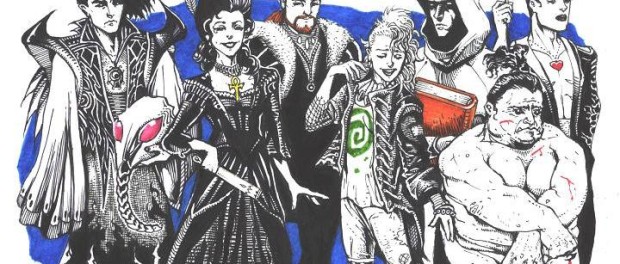Sweet Dreams Are Made of… The Sandman Series
Neil Gaiman was born in Hampshire, England, 1960. Additionally, it would be important to note that he was not born with a vestigial tail. Nor is he afraid of mirrors. Neil Gaiman is, however, one of the most notable writers of our time. He is also too modest to admit it himself. Nevertheless, Neil Gaiman knows it, and so do all of his zealous readers. Coraline was beautifully warped. Good Omens was quite simply hilarious. And the Sandman series… No words can truly render it its value. Published by Vertigo from 1989 to 1996, the 75 issues that comprise this beautiful graphic novella series are collected in ten mind-boggling trade paperbacks. Mind-boggling is indeed the best way to put it, since if you do not reach moksha by volume 3, you will most definitely hit nirvana by volume 7.
The Sandman Series follows the Endless Siblings and their twisted interactions amongst themselves and the human world. Masterfully personifying the abstract concepts of Dream, Delirium, Death, Destruction, Despair, Desire and Destiny, Neil Gaiman creates characters both surreal and incredibly humane. The series is naturally named after its main protagonist, Dream, also known as the Sandman, Morpheus or Lord of the Dreaming. It follows Morpheus’ incredibly interesting psychological evolution as he starts to realize a crucial aspect of his own existence: humanity is not enslaved to the Endless, but the Endless are enslaved to humanity.
Gradually, the series reveals the multi-faceted personalities of each Endless sibling. The morose Dream is distinguishable for his obsession with “responsibility” and failed love affairs, while Despair stands out for her fixation on self-mutilation. Death and Destiny both express a mature sense of fatality, while the genderless Desire is full of evil schemes. Ironically enough, Destruction indulges in the creation of art, while the naïve and somewhat incoherent Delirium makes the truest statements. In fact, Delirium is the most multidimensional of the Endless siblings. Her ever-changing appearance and colorful dialogue balloons are a source of curiosity as it is, but the biggest enigma around her is how she got corrupted from being Delight (her previous identity) into Delirium…
Through the Sandman series, Gaiman cleverly bestows his extensive cultural knowledge upon all readers meticulous enough to appreciate the intricacy of his work. The eclectic variety of characters ranges from spirited transvestites to mythological and religious figures. For instance, the series comprises an incredibly lazy Lucifer (the Devil), a terribly manipulative Loki (Norse Mythology), the cruel Doctor Destiny (DC universe), a romantic Orpheus (Greek mythology) and many more. Gaiman spins a motley of legends and beliefs together to weave one wildly dark and imaginative fairytale.
Gaiman, master of detail, could in fact be qualified as the 21st century dark fantasy version of Arthur Conan Doyle. With treacherously subtle foreshadowing and clever cultural references, the series encompasses such an infinite amount of hidden symbolism that it is hard to belief it was written by a single man. Some captions even include something of a soundtrack to the scene, with speech balloons for fragments of song lyrics.
Preludes & Nocturnes (volume 1) gives the series an incredibly disturbing start once Doctor Destiny spreads perversion upon his escape from Arkham Asylum. The Doll’s House (volume 2) continues on a note just as dark when the main human protagonist has to search for her little brother at a murderers’ convention. Dream Country (volume 3) and Fables and Reflections (volume 6) follow several different tales, accurately showing Gaiman’s narrative genius – he has a lot of fun inserting narratives within narratives, creating hundreds of original subplots and twists (a whole new dimension of “narrative-ception”). Other volumes of the series focus on Dream’s siblings, such as his relationship with serene Death and childish Delirium. At first, it may seem hard to find a connection between one volume and the next. It is only upon finishing the series that the reader realizes how brilliantly intertwined each subplot is, especially with the main conflict of the series: Dream’s growing struggle between his sense responsibility and rising compassion towards humans.
Another noteworthy aspect of the series is its visual beauty. Penciled, inked, lettered and colored by over twenty different artists, the Sandman Series pictures are noticeably different in each issue while maintaining the classic old-school oversaturation of colors and contrast. It is quite interesting to see the diversity of style in which the same characters can be portrayed.
The contrast between tenderness and perversity, love and darkness, make Sandman a most memorable read. Neil Gaiman’s unlimited pool of creativity is both a source of awe and jealousy. The whole series can be summarized by Gaiman’s following quote: “That which is dreamed can never be lost, can never be undreamed.” Make sure to add these graphic novels to your Christmas shopping list.







